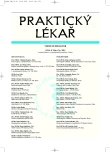Restoration of hand movement following irreparable radial nerve palsy
Authors:
Čižmář . 1 1; D. Ira 2; J. Pilný 3; P. Dráč 1; Dospěl I.. 1
Authors‘ workplace:
Traumatologické oddělení FN Olomouc Primář: MUDr. Igor Čižmář, Ph. D.
1; Traumatologické klinika FN Brno Bohunice Přednosta: doc. MUDr. Michal Mašek, CSc.
2; Ortopedické oddělení Krajské nemocnice Pardubice Primář: MUDr. Jiň Kubeš
3
Published in:
Prakt. Lék. 2006; 86(12): 718-721
Category:
Therapy
Overview
Loss of radial nerve function causes significant limitation of hand usage. A patient is not able to extend their wrist, fingers and thumbs, and consequently has great problems gripping objects. Gripping objects and poor grip strength, as a result of extension loss in the wrist, are the most difficult handicaps for the patient. In cases where the effect of nerve reconstructions implies worse functional results, a tendon transfer - which eliminates the potential negative results of nerve restoration - should be carried out as part of these procedures.
Key words:
Paresis, nervus radialis, tendon transfer
Labels
General practitioner for children and adolescents General practitioner for adultsArticle was published in
General Practitioner

2006 Issue 12
Most read in this issue
- Severe lactic acidosis associated with acute renal failure in a diabetic patient treated with metformin – A case study.
- Role of coronary calcium scoring in a spectrum of examination procedures
- Restoration of hand movement following irreparable radial nerve palsy
- Neurosyphilis
